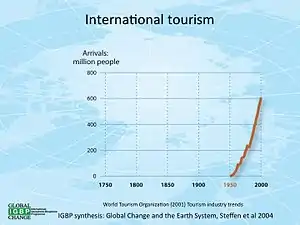International tourism
International tourism refers to tourism that crosses national borders. Globalization has made tourism a popular global leisure activity. The World Tourism Organization defines tourists as people "traveling to and staying in places outside their usual environment for not more than one consecutive year for leisure, business and other purposes".[1] The World Health Organization (WHO) estimates that up to 500,000 people are in flight at any one time.[2]


In 2010, international tourism reached US$919B, growing 6.5% over 2009, corresponding to an increase in real terms of 4.7%.[3] In 2010, there were over 940 million international tourist arrivals worldwide.[4] By 2016 that number had risen to 1,235 million, producing 1,220 billion USD in destination spending.[5] The COVID-19 crisis had significant negative effects on international tourism significantly slowing the overall increasing trend.
International tourism has significant impacts on the environment, exacerbated in part by the problems created by air travel but also by other issues, including wealthy tourists bringing lifestyles that stress local infrastructure, water and trash systems among others.
History
As a result of the late-2000s recession, international travel demand suffered a strong slowdown from the second half of 2008 through the end of 2009.[6] This negative trend intensified during 2009, exacerbated in some countries due to the outbreak of the H1N1 influenza virus, resulting in a worldwide decline of 4.2% in 2009 to 880 million international tourists arrivals, and a 5.7% decline in international tourism receipts.[7]
COVID 19
The COVID-19 pandemic has a huge impact on the tourism industry due to the resulting travel restrictions as well as slump in demand among travelers. The tourism industry has been massively affected by the spread of coronavirus, as many countries have introduced travel restrictions in an attempt to contain its spread.[8] The United Nations World Tourism Organization estimated that global international tourist arrivals might decrease by 58% to 78% in 2020, leading to a potential loss of US$0.9–1.2 trillion in international tourism receipts.[9]
In many of the world's cities, planned travel went down by 80–90%.[10] Conflicting and unilateral travel restrictions occurred regionally[11][12] and many tourist attractions around the world, such as museums, amusement parks, and sports venues closed. UNWTO reported a 65% drop in international tourist arrivals in the first six months of 2020.[13] Air passenger travel showed a similar decline.[14]Rankings
Total volume of cross-border tourist travel
International tourist arrivals reached 1.035 billion in 2012, up from over 996 million in 2011, and 952 million in 2010.[15] In 2011 and 2012, international travel demand continued to recover from the losses resulting from the late-2000s recession, where tourism suffered a strong slowdown from the second half of 2008 through the end of 2009. After a 5% increase in the first half of 2008, growth in international tourist arrivals moved into negative territory in the second half of 2008, and ended up only 2% for the year, compared to a 7% increase in 2007.[16] The negative trend intensified during 2009, exacerbated in some countries due to the outbreak of the H1N1 influenza virus, resulting in a worldwide decline of 4.2% in 2009 to 880 million international tourists arrivals, and a 5.7% decline in international tourism receipts.[17]
World's top tourism destinations
In 2019 there were 1.460 billion international tourist arrivals worldwide, with a growth of 3.7% as compared to 2018.[18] The World Tourism Organization reports the following ten destinations as the most visited in terms of the number of international travelers in 2019.
| Rank | Destination | International tourist arrivals (2019)[18] |
International tourist arrivals (2018)[18] | Change (2018 to 2019) (%) | Change (2017 to 2018) (%) |
|---|---|---|---|---|---|
| 1 | 89 million[lower-roman 1] | 89.4 million | |||
| 2 | 83.5 million | 82.8 million | |||
| 3 | 79.3 million | 79.7 million | |||
| 4 | 65.7 million | 62.9 million | |||
| 5 | 64.5 million | 61.6 million | |||
| 6 | 51.2 million | 45.8 million | |||
| 7 | 45.0 million | 41.3 million | |||
| 8 | 39.8 million | 38.2 million | |||
| 9 | 39.6 million | 38.9 million | |||
| 10 | 39.4 million | 38.7 million | |||
Notes
| |||||
International tourism receipts
The World Tourism Organization reports that international tourism receipts were US$1.7 trillion in 2018, an increase in real terms of 4% over 2017.[19] The top ten tourism earners in 2018 were:
| Rank | Country/Area | International
tourism receipts (2018)[19] |
|---|---|---|
| 1 | $214 billion | |
| 2 | $74 billion | |
| 3 | $67 billion | |
| 4 | $63 billion | |
| 5 | $52 billion | |
| 6 | $49 billion | |
| 7 | $45 billion | |
| 8 | $43 billion | |
| 9 | $41 billion | |
| 10 | $40 billion | |
International tourism expenditure
The World Tourism Organization reports the following countries as the ten biggest spenders on international tourism for the year 2018.[19]
| Rank | Country | International
tourism expenditure (2018)[19] |
|---|---|---|
| 1 | $277 billion | |
| 2 | $144 billion | |
| 3 | $94 billion | |
| 4 | $76 billion | |
| 5 | $48 billion | |
| 6 | $37 billion | |
| 7 | $35 billion | |
| 8 | $33 billion | |
| 9 | $32 billion | |
| 10 | $30 billion | |
Euromonitor International Top City Destinations Ranking
Euromonitor International rated these the world's most visited cities by international tourists in 2017:[20]
| Rank | City | Country | International
tourist arrivals[21] |
|---|---|---|---|
| 1 | Hong Kong | 27.88 million | |
| 2 | Bangkok | 22.45 million | |
| 3 | London | 19.82 million | |
| 4 | Singapore | 17.61 million | |
| 5 | Cairo | 17.33 million | |
| 6 | Paris | 15.83 million | |
| 7 | Dubai | 15.79 million | |
| 8 | New York City | 13.10 million | |
| 9 | Macau | 12.84 million | |
| 10 | Kuala Lumpur | 12.47 million | |
World Travel and Tourism Council
| Rank | Country | Percentage |
|---|---|---|
| 1 | 73.5% | |
| 2 | 49.8% | |
| 3 | 36.4% | |
| 4 | 34.1% | |
| 5 | 30.1% | |
| 6 | 26.4% | |
| 7 | 25.5% | |
| 8 | 22.7% | |
| 9 | 20.0% | |
| 10 | 19.5% |
| Rank | Country | Percentage |
|---|---|---|
| 1 | 46.1% | |
| 2 | 24.4% | |
| 3 | 20.1% | |
| 4 | 15.4% | |
| 5 | 15.2% | |
| 6 | 14.2% | |
| 7 | 12.1% | |
| 8 | 11.2% | |
| 9 | 10.7% | |
| 10 | 10.7% |
References
- "UNWTO technical manual: Collection of Tourism Expenditure Statistics" (PDF). World Tourism Organization. 1995. p. 14. Archived from the original (PDF) on 22 September 2010. Retrieved 26 March 2009.
- Swine flu prompts EU warning on travel to US. The Guardian. 28 April 2009.
- "UNWTO World Tourism Barometer June 2009" (PDF). UNWTO World Tourism Barometer. World Tourism Organization. 7 (2). June 2011. Archived from the original (PDF) on 19 November 2011. Retrieved 3 August 2009.
- "2011 Highlights" (PDF). UNWTO World Tourism Highlights. UNWTO. June 2011. Archived from the original (PDF) on 13 January 2012. Retrieved 9 January 2012.
- World Tourism Organization (UNWTO) (2017-07-01). UNWTO Tourism Highlights: 2017 Edition. World Tourism Organization (UNWTO). doi:10.18111/9789284419029. ISBN 978-92-844-1902-9.
- "International tourism challenged by deteriorating global economy" (PDF). UNWTO World Tourism Barometer. World Tourism Organization. 7 (1). January 2009. Archived from the original (PDF) on 2013-10-17. Retrieved 17 November 2011.
- "UNWTO World Tourism Barometer Interim Update" (PDF). UNWTO World Tourism Barometer. World Tourism Organization. August 2010. Archived from the original (PDF) on 2013-10-17. Retrieved 17 November 2011.
- "BBC Business News". BBC News. Retrieved 2020-05-25.
- "International Tourist Numbers Could Fall 60-80% in 2020". www.unwto.org. Retrieved 16 September 2020.
- Team, The Visual and Data Journalism (28 March 2020). "Coronavirus: A visual guide to the pandemic". BBC News. Archived from the original on 27 March 2020.
- "EU's Politics-Oriented Approach To Border Reopening Is Risking Recovery". Schengen Visa Info. 13 July 2020. Archived from the original on 13 July 2020.
- "Airlines and Airports Warn European PMs on Inconsistent Approach to Travel Restrictions". Schengen Visa Info. 4 August 2020. Archived from the original on 16 August 2020.
- "International Tourist Numbers Down 65% in First Half of 2020". www.unwto.org. Retrieved 16 September 2020.
- "Airlines may need to retool routes with decline in business travel". Marketplace. 2020-08-26. Retrieved 2020-11-06.
- "UNWTO World Tourism Barometer" (PDF). UNWTO World Tourism Barometer. 11 (1). January 2013. Archived from the original (PDF) on 28 February 2013. Retrieved 9 April 2013.
- "International tourism challenged by deteriorating global economy" (PDF). UNWTO World Tourism Barometer. 7 (1). January 2009. Archived from the original (PDF) on 17 October 2013. Retrieved 17 November 2011.
- "UNWTO World Tourism Barometer Interim Update" (PDF). UNWTO World Tourism Barometer. August 2010. Archived from the original (PDF) on 17 October 2013. Retrieved 17 November 2011.
- "International Tourism Highlights, 2020 Edition". World Tourism Organization. Retrieved 2021-01-27.
- International Tourism Highlights. UNWTO. 2020. doi:10.18111/9789284421152. ISBN 9789284421152.
- "World's most visited cities". CNN. 3 December 2018.
- "Top 100 City Destinations Ranking". Euromonitor International. 27 December 2018.
- "Countries Showing Strong International Travel and Tourism Growth" (PDF).
- "Which Countries Performed Best In 2016?" (PDF). p. 7.